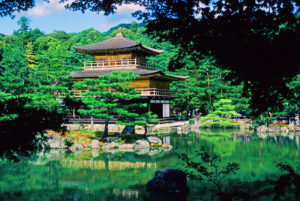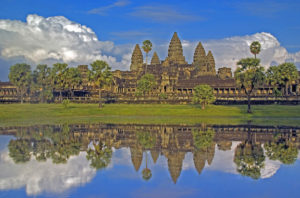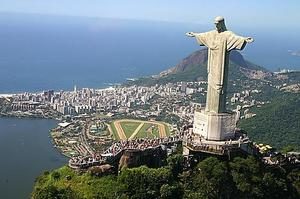
Kyoto’s Kinkaku-ji Zen Buddhist Temple of the Golden Pavilion. Photo by Dennis Cox/WorldViews
Barcelona, Spain. Udaipur, India. Siem Reap, Cambodia.
Rome and Florence, Italy. Santa Fe, New Mexico and Charleston, South Carolina, U.S..
Luang Prabang, Laos. Ubud, Indonesia (Bali).
Cape Town, South Africa. Hoi An, Vietnam.
Kyoto, Japan. Chiang Mai, Thailand.
Oaxaca and San Miguel de Allende, Mexico.
What do these cities have in common? If you said “very little,” you’;d be right, but you’d also be wrong.
They were all voted into the top 15 of the “World’s Top Cities” by the readers of Travel + Leisure Magazine. The criteria included sights/landmarks, culture, cuisine, friendliness, shopping, and overall value.
Where are the Usual Suspects?
Notable absences include London, Paris,. Venice, Prague, St. Petersburg, Istanbul, Jerusalem, Rio de Janeiro, Buenos Aires, New York, Chicago, San Francisco, Vancouver, Hong Kong…not even such trendy destinations as Berlin, Lisbon, Budapest, Dubrovnik, Toronto, or Tucson.
(OK, I threw in Tucson as a shameless plug for my soon-to-be-published book, 100 Things to Do in Tucson Before You Die, from Reedy Press in St. Louis. Available in mid-August wherever fine books are sold.)
It’s obvious that T&L readers are mostly looking at Europe in the rear-view mirror and moving on to more exotic climes. Only Rome, Florence, and Barcelona made the list from Europe, and the latter barely squeezed in at number 15.

Cambodia: Angkor Wat Temple. Photo by Dennis Cox/WorldViews
Another obvious conclusion is that T&L readers are enamored of South East Asia: so much so that they voted for Siem Reap, Cambodia — known primarily as the Gateway to Angkor Wat — as their number 13 favorite city, and Ubud, Indonesia, on the island of Bali, as number nine.
Ubud may be the “cultural heart” of Bali, set in a scenic mountain location, but I found the city itself to be overdeveloped and over-commercialized.
How Long Has Luang Prabang Been on Your Radar?
I applaud the readers of T&L for venturing off the beaten track a bit to honor Luang Prabang, Laos,and Hoi An, Vietnam — two newly trendy destinations that draw raves from visitors. Luang Prabang is near the top of my own bucket list and I’d love to return to Hoi An — but I have to admit, until recently Luang Prabang was completely off my radar.
Chiang Mai, situated in the mountains of northern Thailand, has been on travelers’ radar for decades as a place to escape the heat, traffic and chaos of Bangkok.
But do these South East Asian cities really surpass London, Paris, and Rio? Or have these famous world-class cities fallen out of favor because of well-publicized incidents of terrorism and (especially in Rio’s case) of crime? Probably — but then you have the case of Cape Town, a ravishingly beautiful city that’s also been beset by crime, yet finished at number eight.
Another possibility lies in “overall value” — Hoi An and other South East Asian cities are dirt cheap, certainly compared to London and Paris. And they’re friendly with great food and cultural attractions, as well.
A Preference for Smaller, “Safer” Cities
With a few exceptions, most of the cities on the list fall into the “small-to-medium-size” category.
Santa Fe and Charleston, the two U.S. representatives, are attractive and charming. I’d much rather see them on the list than, say, Las Vegas. But New York, Chicago, and San Francisco — for all their urban ills — still get my heart racing with their depth of sights, museums, restaurants, ethnic diversity, and scenic waterfronts.

Despite its beauty and sultry reputation, Rio didn’t make the cut.. Photo from riodejaneiro.com.
In Mexico, Oaxaca and San Miguel de Allende get the nod. San Miguel — with its authentic colonial architecture and atmosphere — actually took the top spot in the survey, evidence that Americans don’t need to travel all that far to find cultural bliss.
Udaipur, India — a city of palaces romantically set on a series of artificial lakes — and Kyoto, Japan, the city of temples, round out the top 15, with Kyoto taking the number four spot behind San Miguel, Charleston, and Chiang Mai and just ahead of Florence, Oaxaca, and Hoi An.
A Few Conclusions
Lists like this come and go and change with the winds and the whims of travelers.
But this list is notable for a few things:
- Travelers — at least the reasonably well-to-do travelers who read Travel + Leisure, which include a lot of baby boomers — are branching out beyond the U.S. and Europe, particularly to South East Asia.
- For the most part, travelers are seeking out smaller cities that retain authentic charm and a rich cultural heritage.
- And, very possibly, travelers like to name-drop exotic locales such as Luang Prabang, Siem Reap, Ubud, and Udaipur, one-upping their neighbors who are still looking forward to their first trip to Paris or London, much less Berlin or Budapest.
If nothing else, lists like this may give you some ideas of where to go next — after all, if that many people voted for Ubud, there must be something there to like.
I guess I’ll have to go back to see what it is.
Readers, what are your favorite cities? Does this list reflect your own preferences or are you more of a London-Paris-New York traditionalist? Let me know your thoughts.












7 Responses to Are These Really the World’s Top Cities?